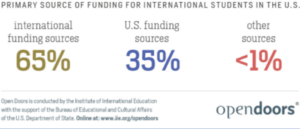Finding funds for your university studies: what are the options?

Let’s face it, university in the United States is expensive. According to the College Board, in 2018-19 the average costs (tuition and fees plus room and board) for public four-year institutions for out-of-state students is $37,430/year, while a private four year college will cost $48,510/year. For international students considering top-level universities, the costs can be even higher, upwards of $75,000 or more per year.
So how do the more than one million international students, according to the Institute of International Education’s (IIE) Annual Open Doors Report, pay for their studies in the U.S.? In 2018, nearly two-thirds of students their primary source of funding comes from overseas according to IIE. As you might guess, most students rely on their personal and family funds (59%), followed by foreign governments, universities, and private sponsors (6%).

Figure 1: Source IIE Open Doors 2018 Infographics
For most families, the decision to study outside your home country is not made lightly. Your parents may have been planning for this possibility for many years. That being said, few can afford the full cost of a U.S. higher education on their own. Most colleges recognize this fact. While U.S. government-sponsored financial aid is only available for U.S. citizens, permanent residents, and refugees, individual colleges can offer need-based and merit-based aid to international students from their institutional sources.
NAFSA, the Association of International Educators, commissions a study each year that takes the Open Doors data to determine the many positive impacts international students have on the United States. Based on past reports, international students annually receive nearly $10 billion in financial assistance from U.S. sources. These sources include scholarships, grants, tuition waivers, assistantships, on-campus jobs, housing from colleges as well as private sponsors, companies.
As you research college options in the United States, you quickly realize how many choices you have. With over 4500 accredited institutions, finding ones that offer financial help to international students is a huge task. The good news is there are several colleges that give substantial aid, but these institutions are some of the most selective in the country, many with acceptance rates under 10%. Our colleagues at U.S. News and World Report indicated that in 2017-18, 451 ranked colleges did offer at least some aid to international undergraduate students, averaging $21,200/year.
According to the IIE Open Doors data referenced earlier, international students seeking master’s and doctorate degrees generally receive more financial assistance. However, there are ways to search for undergraduate scholarships and grants. For prospective undergraduate students, EducationUSA, the U.S. Department of State’s network of advising centers in over 170 countries, is an invaluable resource. Their advising centers have access to an annually-updated list of institutions offering international students scholarships/aid, including 100+ colleges that offer full financial aid to qualified international students.
Students should also contact their local EducationUSA office to inquire on what might also be available through in-country sources. Some additional resources are available to find current scholarships include IIE’s Funding U.S. Study and EducationUSA’s Your 5 Steps to U.S. Study, which provides many tips to find financial support, including a searchable database of financial aid. Be sure to also check out the #YouAreWelcomeHere national scholarship program, which includes 57 colleges and universities that are offering at least two (per institution) scholarships valued at a minimum of 50% of the tuition costs at each institution.
As with anything worth pursuing, you will need to do significant research to find potential options. The good news is there are many excellent U.S. colleges eager to have you, so be sure to feel comfortable asking if the institutions you are considering offer aid. If you don’t ask, you won’t receive aid. So don’t be afraid to ask!